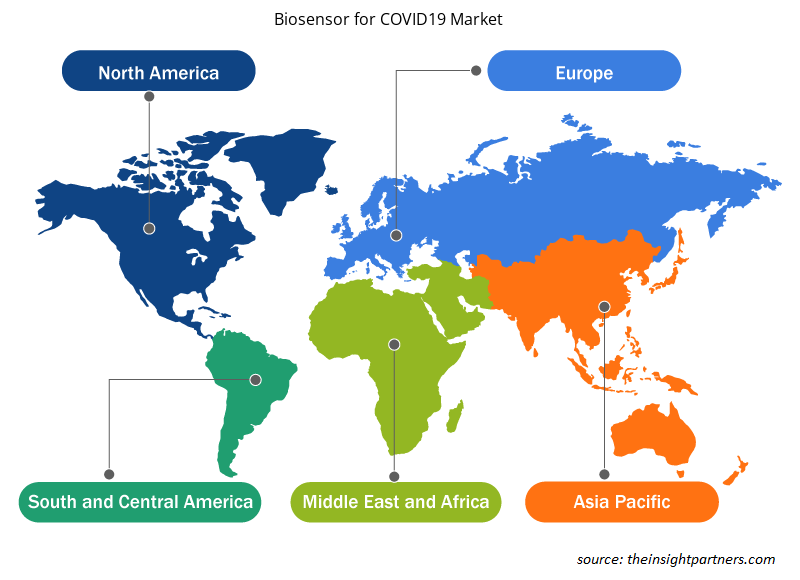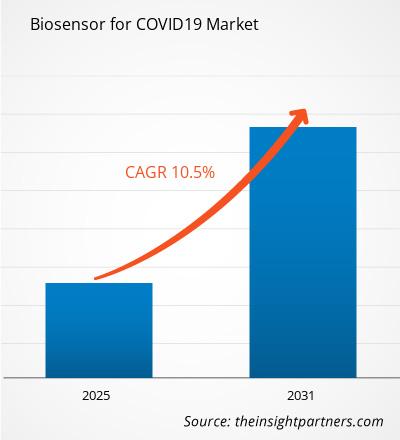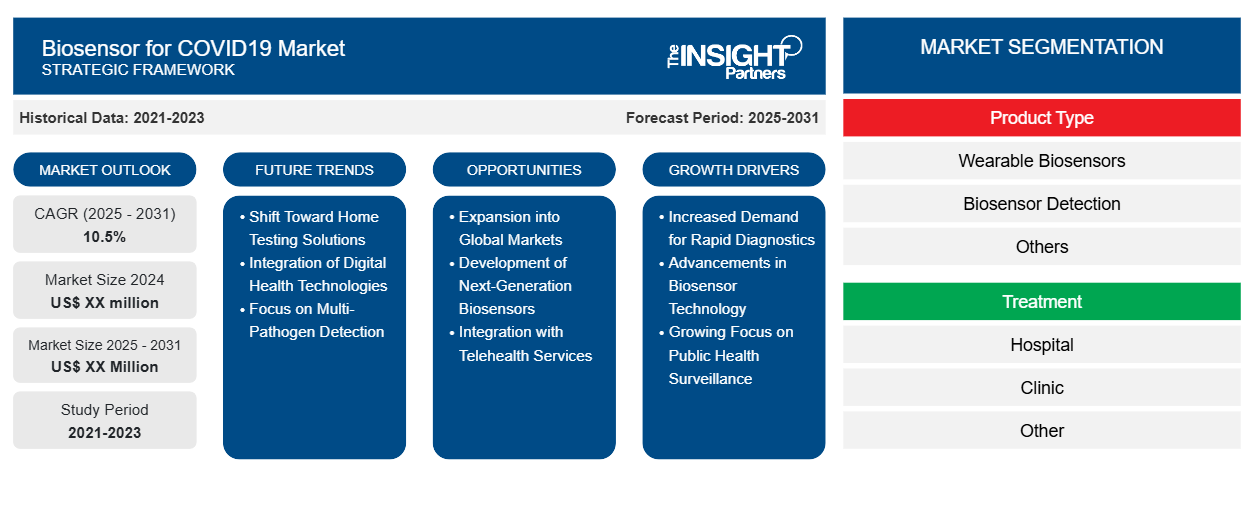预计 2023 年至 2031 年 COVID-19 生物传感器市场复合年增长率为 10.5%,市场规模将从 2023 年的 XX 百万美元扩大到 2031 年的 XX 百万美元。
报告按产品类型(可穿戴生物传感器、生物传感器检测、其他)进行细分。根据治疗方式,市场分为医院、诊所、其他。全球分析进一步细分为区域和主要国家。报告以美元为单位提供上述分析和细分的价值。
报告目的
The Insight Partners 撰写的《COVID-19 市场生物传感器》报告旨在描述当前形势和未来增长、主要驱动因素、挑战和机遇。这将为各种业务利益相关者提供见解,例如:
- 技术提供商/制造商:了解不断变化的市场动态并了解潜在的增长机会,从而能够做出明智的战略决策。
- 投资者:对市场增长率、市场财务预测以及整个价值链中存在的机会进行全面的趋势分析。
- 监管机构:监管市场政策和警察活动,旨在最大限度地减少滥用行为,维护投资者的信任和信心,维护市场的完整性和稳定性。
COVID-19 生物传感器市场细分
产品类型
- 可穿戴生物传感器
- 生物传感器检测
- 其他的
治疗
- 医院
- 诊所
- 其他
定制此报告以满足您的需求
您可以免费定制任何报告,包括本报告的部分内容、国家级分析、Excel 数据包,以及为初创企业和大学提供优惠和折扣
- 获取此报告的关键市场趋势。这个免费样品将包括数据分析,从市场趋势到估计和预测。
COVID-19 生物传感器市场增长动力
- 快速诊断需求增加:由于对快速可靠的 COVID-19 诊断测试的需求增加,生物传感器市场受到了巨大影响。毫无疑问,随着医疗保健系统试图控制疫情,即时检测的数量有所增加。生物传感器可在短时间内给出结果;因此,它们有助于制定治疗和控制决策,从而有助于对抗病毒。
- 生物传感器技术的进步:生物传感器技术最近经历了一些改进,由于生物传感器的灵敏度和特异性提高以及易用性,推动了市场的增长。此类发展包括手持设备和芯片实验室系统,它们正在彻底改变 COVID-19 的诊断和治疗。由于开发中心、医院和家庭对测试解决方案的需求导致市场机会增长,因此考虑了此类发展。
- 公共卫生监测日益受到关注:随着对了解疾病传播和控制 COVID-19 的需求,对用于监测目的的生物传感器的需求激增。作为一种可行的解决方案,这些政府和卫生组织正致力于实施用于感染监测和控制目的的复杂诊断设备。现有的初级干预需求使生物传感器能够轻松集成到疾病控制管理计划中。
COVID-19 生物传感器市场未来趋势
- 转向家庭检测解决方案:COVID-19 生物传感器领域的另一个重要发展是转向针对家庭检测解决方案的活动。鉴于消费者正在寻找更好、更快的方式来照顾他们的健康,许多公司正在将生物传感器引入消费市场,以便他们可以在家中检测 COVID-19。这一趋势不仅使医疗保健更容易获得,而且还促进了更好的健康实践,因为人们倾向于更定期地监测他们的健康状况。
- 数字健康技术的整合:有趣的是,生物传感器功能与数字健康技术的融合正成为焦点。许多生物传感器开发商现在正在添加移动应用程序和云服务,以便为用户提供即时结果和健康监测服务。通过这种方式,它改善了信息管理,并通过促进健康服务的提供来吸引客户,即使距离是一个问题。
- 专注于多病原体检测:然而,已经有明显的技术进步专注于开发针对多种病原体的多传感器生物传感器,包括导致 COVID-19 和其他流感病毒株不同变体的病原体。这种多种能力对于全方位的公共卫生干预措施来说非常不错。除此之外,这些高性能生物传感系统可用于诊断多种疾病,从而能够更有效地管理患者并更好地处理流行病。
生物传感器助力应对新冠肺炎疫情
- 拓展全球市场:COVID-19 时代为生物传感器市场的扩张提供了最具吸引力的潜力,尤其是对欠发达国家而言。随着各国医疗保健系统的完善和快速检测需求的增长,制造商能够相应地设计其产品。在这方面,与当地政府和医疗机构的合作将有利于其市场增长并支持该地区的卫生政策。
- 下一代生物传感器的开发:下一代生物传感器是技术变革的核心,具有显著先进的测量技术和不同程度的微型化。使用纳米结构等复合材料和生物传感器研究可能有助于创造比当今市场上更好的解决方案。用于这些创新的研发资金可以帮助公司在生物传感器行业中占据领先地位,并满足医学领域不断变化的需求。
- 与远程医疗服务的整合:生物传感器与远程医疗服务的结合也可以被视为 COVID 19 市场的一个巨大机会。鉴于远程医疗的吸引力日益增加,将生物传感器技术集成到远程医疗平台中以实现有效的患者监测和数据交换的趋势日益增长。这种结合的好处在于它提高了护理质量,带来了更好的健康结果,并鼓励越来越多的受众在日常健康管理中使用生物传感器。
COVID19 生物传感器市场区域洞察
Insight Partners 的分析师已详细解释了预测期内影响 COVID19 生物传感器市场的区域趋势和因素。本节还讨论了 COVID19 生物传感器市场的各个细分市场和地理位置,包括北美、欧洲、亚太地区、中东和非洲以及南美和中美洲。

- 获取 COVID19 市场生物传感器的区域特定数据
COVID19 生物传感器市场报告范围
| 报告属性 | 细节 |
|---|---|
| 2023 年的市场规模 | XX 百万美元 |
| 2031 年市场规模 | XX 百万美元 |
| 全球复合年增长率(2023 - 2031) | 10.5% |
| 史料 | 2021-2022 |
| 预测期 | 2024-2031 |
| 涵盖的领域 | 按产品类型
|
| 覆盖地区和国家 | 北美
|
| 市场领导者和主要公司简介 |
|
COVID19 生物传感器市场参与者密度:了解其对业务动态的影响
由于消费者偏好的不断变化、技术进步以及对产品优势的认识不断提高等因素,终端用户需求不断增加,推动 COVID19 生物传感器市场快速增长。随着需求的增加,企业正在扩大其产品范围,进行创新以满足消费者需求,并利用新兴趋势,从而进一步推动市场增长。
市场参与者密度是指在特定市场或行业内运营的企业或公司的分布情况。它表明在给定市场空间中,相对于其规模或总市场价值,有多少竞争对手(市场参与者)存在。
在 COVID19 生物传感器市场运营的主要公司有:
- 雅培
- 西门子
- 美敦力
- F. 霍夫曼-拉罗什
- 艾康实验室
免责声明:上面列出的公司没有按照任何特定顺序排列。

- 获取 COVID19 生物传感器市场主要参与者概览
主要卖点
- 全面覆盖:该报告全面涵盖了 COVID-19 生物传感器市场的产品、服务、类型和最终用户的分析,提供了整体概况。
- 专家分析:报告基于对行业专家和分析师的深入了解而编写。
- 最新信息:该报告涵盖了最新信息和数据趋势,确保了其与业务的相关性。
- 定制选项:此报告可以定制以满足特定客户要求并恰当地适应业务策略。
因此,COVID-19 生物传感器市场研究报告有助于引领解读和了解行业情景和增长前景。尽管可能存在一些合理的担忧,但本报告的总体优势往往大于劣势。
- 历史分析(2 年)、基准年、预测(7 年)及复合年增长率
- PEST和SWOT分析
- 市场规模、价值/数量 - 全球、区域、国家
- 行业和竞争格局
- Excel 数据集
近期报告
相关报告
客户评价
购买理由
- 明智的决策
- 了解市场动态
- 竞争分析
- 客户洞察
- 市场预测
- 风险规避
- 战略规划
- 投资论证
- 识别新兴市场
- 优化营销策略
- 提升运营效率
- 顺应监管趋势





















 获取免费样品 - COVID19 市场生物传感器
获取免费样品 - COVID19 市场生物传感器